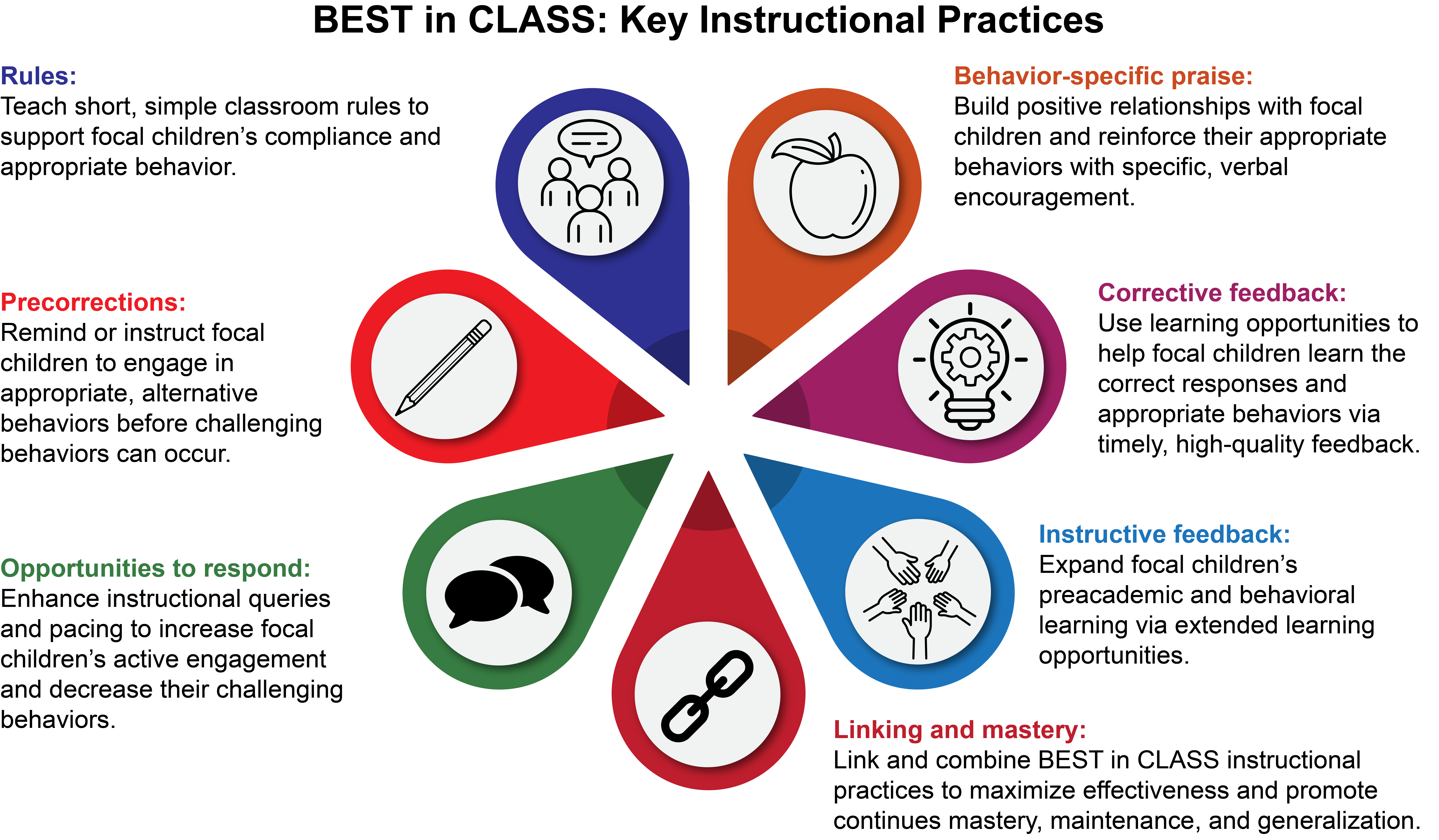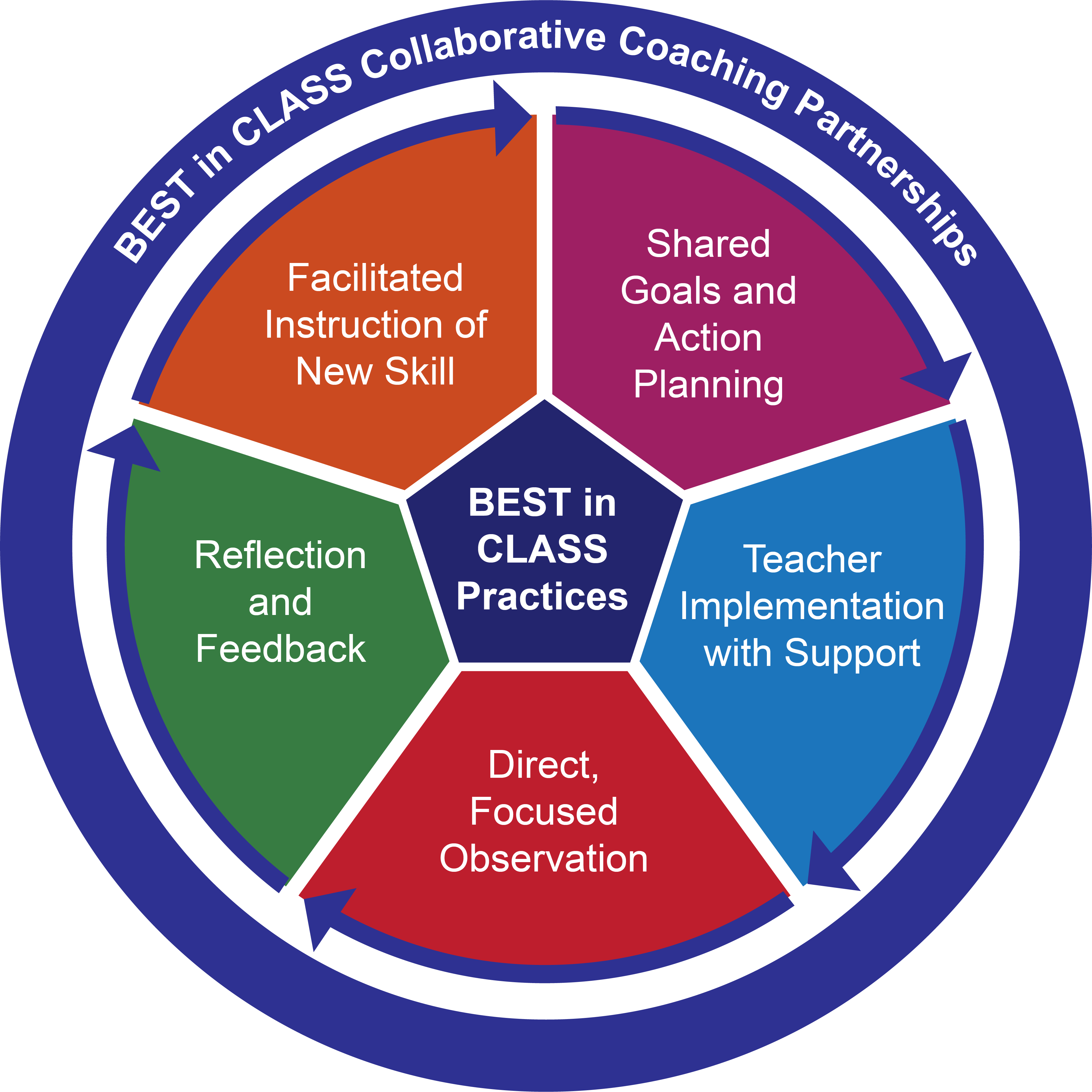BEST in CLASS: What Coaches and Teachers Say About It
Part 1: Coach Perspectives
What is BEST in CLASS?
BEST in CLASS (Behavioral, Emotional, and Social Training: Competent Learners Achieving School Success) is a tier 2 (targeted) evidence-based intervention for young children with persistent and intensive challenging behaviors. Developed by Drs. Maureen Conroy (University of Florida) and Kevin Sutherland (Virginia Commonwealth University), the program enhances teachers’ use of proven practices during authentic learning activities (e.g., circle time, small group) that prevent behavior problems and support learning. BEST in CLASS provides teachers practice based coaching with an experienced teacher or behavior specialist to support teachers’ use of key instructional practices through a strengths-based process of collaborative goal-setting, action planning, reflection and feedback, and resources.

What does the BEST in CLASS program look like in action for coaches?
The program consists of the following major components:
- In a 3-day workshop, BEST in CLASS trainers introduce BEST in CLASS strategies, practice-based coaching, and classroom observation methods to coaches.
- Coaches also attend a 1-day teacher training workshop where they build alliance with their teachers, receive additional training to reinforce their knowledge of BEST in CLASS practices, and initiate the coaching process.
- Each coach also receives a BEST in CLASS coach and teacher handbook with details on how to support teachers and implement rules, pre-correction, behavior specific praise, opportunities to respond, corrective feedback, and instructive feedback.
- Coaches attend weekly coaching community sessions with peer and site coordinator coaches for professional support and guidance as they implement practice-based coaching for 14 weeks.
What is practice based coaching?
Practice-based coaching (PBC) was originally developed by Dr. Patricia Snyder (University of Florida) and her colleagues, Dr. Mary Louise Hemmeter (Vanderbilt University) and Lise Fox (University of South Florida). PBC promotes a strong collaborative partnership between teachers and coaches to facilitate the use of effective instructional practices in early childhood education settings. In its cyclical process, the BEST in CLASS PBC model includes skill instruction on each practice, the development of shared goals and action planning, implementation support, classroom observation, and reflection and feedback (Sutherland et al., 2015). Coaches and teachers work together to build rapport and mutually respectful and trusting partnerships by sharing their experiences and discussing their goals and priorities (Snyder et al., 2022).

What is the BEST in CLASS study that SRI researchers are conducting?
SRI and our partners at the University of Florida and Virginia Commonwealth University are conducting a large-scale research study to examine the implementation and effectiveness of BEST in CLASS in Head Start settings.1
Previous studies using teacher surveys and independent observations have shown that BEST in CLASS promotes improvements in child outcomes including reductions in problem behaviors, improved social skills, and increased engagement and on-task behavior (Sutherland et al., 2018). Independent observers verified that BEST in CLASS teachers increased their use of evidence-based instructional practices associated with improved child outcomes (Conroy et al., 2019). Participating teachers also reported that BEST in CLASS improved their self-efficacy and enhanced their positive classroom environments (Conroy et al., 2019).
Positive outcomes for teachers
- Improved teacher-child relationships
- Increased self-efficacy
- Improved classroom atmosphere
Positive outcomes for children
- Increased engagement and on task behavior
- Increased positive teacher-child interactions
- Decreased problem behavior
- Increased social skills
What do coaches in the SRI study say about BEST in CLASS?
SRI researchers recently conducted focus groups with Head Start coaches and their site coordinators (who provide guidance and support to them in their coaching role). The coaches shared the following highlights about their experiences with participating in BEST in CLASS coach trainings and helping teachers implement BEST in CLASS practices:
- BEST in class provides a clear set of tools that teachers can use to prevent challenging behaviors before they occur.
“A lot of teachers come, and they want you to give them something tangible to do. […] I think these tools are things that can help them. I can give you a tangible practice to use so that you can be ahead of the behavior, being in front of instead of behind it.”“I liked it that it was trying to step in ahead of the challenging practices. […] It gave the teachers the tools to identify and try to help that child before there were incidents.”“This is the first time I felt like I had real strategies to provide the teachers that I coach.”
- The binder, practice sessions, videos, and the training all put the BEST in CLASS program into concrete, do-able terms.
- Weekly coaching community sessions supported coaches in feeling more prepared and comfortable to coach teachers in BEST in CLASS. Coaches were able to prepare for the next week of coaching, receive guidance on coaching teachers on BEST in CLASS practices, and reflect on feedback on their coaching. Weekly coaching community sessions also offered a space for coaches to share their practices, problem-solve through situations, and learn from each other.
“The social aspect of it, like touching base and talking about the little quirky things about our teachers […] was nice. […]”“I think those sessions were very helpful, because during my feedback sessions, if I had questions, I was able to ask. ‘Did I handle this correctly?’ So I feel ready if I have this come up in the future. The guidance that they provide me was really good. Being able to send my paperwork in early, so when we get to the session, they were already prepared, and they had already given me feedback.”
- Although BEST in CLASS is a tier 2 intervention, all children can benefit.
“I plan on continuing to use it, BEST in CLASS, because a lot of the practices, they are useful, not just for the people who are in BEST in CLASS, but I think it’s a great baseline for everybody. A great tier 1 tool for everybody.”
- The BEST in CLASS practices link together, and there are connections among the modules—the practices flow and build upon each other.
“It was an eye opener about how they link, how easy it flows, and how powerful it can be.”“The first year that I used the practices, I was amazed. I’m absolutely continuing to do these things because it made such a difference!”
- The practice-based coaching was not intrusive, and coaches were not there to tell the teachers what was right or wrong—they were there to help teachers enhance what they were already doing and praise them for a great job.
- The coaches use a lot of different communication methods, including referencing the BEST in CLASS manual (going back and reviewing techniques) and allowing teachers to talk freely and openly. The coaches also make themselves available by email, phone, and in person at the school to answer questions.
What do teachers in the SRI study say about BEST in CLASS?
We hope you will read Part 2 of our next blog post to find out! Stay tuned!
Footnotes
References and Additional Resources
Snyder, P. A., Hemmeter, M. L., & Fox, L. (2015). Supporting implementation of evidence-based practices through practice-based coaching. Topics in Early Childhood Special Education, 35(3), 133-143. https://doi.org/10.1177/0271121415594925
Snyder, P. A., Hemmeter, M. L., & Fox, L. (2022). Essentials of Practice-Based Coaching: Supporting effective practices in early childhood. Brookes Publishing Company.
Sutherland, K. S., Conroy, M. A., Vo, A., & Ladwig, C. (2015). Implementation integrity of practice-based coaching: Preliminary results from the BEST in CLASS efficacy trial. School Mental Health, 7, 21-33. https://doi.org/10.1007/s12310-014-9134-8
Sutherland, K. S., Conroy, M. A., Algina, J., Ladwig, C., Jessee, G., & Gyure, M. (2018). Reducing child problem behaviors and improving teacher-child interactions and relationships: A randomized controlled trial of BEST in CLASS. Early Childhood Research Quarterly, 42, 31-43. https://doi.org/10.1016/j.ecresq.2017.08.001
Topics: Classroom-based intervention Early childhood Educator professional development and support Externalizing behaviors Internalizing behaviors Researcher-practitioner partnership Social-emotional learning
Tags: Behavior support BEST in CLASS Head Start Practice-based coaching
